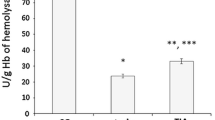Summary
It is believed that free radical formation and subsequent oxidative damage in the form of lipid peroxidation may be a factor in the cerebral damage secondary to the ischaemia of a cerebrovascular accident (CVA). Total serum ascorbate and malondialdehyde (MDA) were measured in 45 patients with CVA on the day of admission to hospital (Time 0) and 48 hours later (Time 48 hours) and also in 45 age and sex matched controls.
There was no statistical difference in total serum ascorbate between the control group (34.2 μmol/ 1 ± 3.1, mean ± SEM) and the CVA patients at Time 0 (37.3 ± 2.9) but there was a statistically significant decrease at Time 48 hours (22.7 ± 2.0) (p < 0.001) in the CVA patients. With MDA there was no statistical difference between the patients at Time 0 (0.79 μmol/l ± 0.06) and the control group (0.83 ± 0.06) but there was a significant increase at Time 48 hours (1.65 ± 0.08) (p < 0.001). These findings are in keeping with possible evidence of free radical damage in CVA.
Similar content being viewed by others
References
Oberly, L. W. Free radicals and diabetes. Free Rad. Biol. Med. 1988; 5: 113–24.
Burrell, C. J., Blake, D. R. Reactive oxygen metabolites and the human myocardium. Br. Heart J. 1989; 61: 4–8.
Andrews, F. J., Blake, D. R., Morris, C. J. Iron and joint inflammation. In: de Sousa, M., Brick, J. H. eds. Iron in Immununity, Cancer and inflammation. Chichester: Wiley, 1989; 145–75.
Demopoulos, H. B., Flamm, E. S., Seligman, M. L. et al. Molecular pathology of lipids in CNS membranes. In Jobsis, F. F. (ed) Oxygen and Physiological Function. Professional Information Library, Dallas, 1977, pp 491–508.
Demopoulos, H. B., Flamm, E. S., Pietronigro, D. D., Seligman, M. L. The free radical pathology and the microcirculation in the major central nervous system disorders. Acta Physiol. Scand. Suppl. 1980; 492: 91–118.
Flamm, E. S., Demopoulos, H. B., Seligman, M. L., Poser, R. G., Ransohoff, J. Free radicals in cerebral ischaemia Stroke 1978; 9: 445–7.
Demopoulos, H. B. The basis of free radical pathology. Fed. Proc. 1973; 32: 1859–1961.
Gaudet, R. J., Levine, L. Transcient cerebral ischaemia and brain prostaglandins. Biochem. Biophys. Res. Commun. 1979; 86: 893–901.
Yoshida, S., Inoh, S., Asano, T. et al. Effect of transcient ischaemia on free fatty acids and phospholipids in the gerbil 491 brain. Lipid peroxidation as a possible cause of post-ischaemic injury. J. Neurosurg. 1980; 53: 323–331.
Cooper, A. J. L., Pulsinelli, W. A., Duffy, T. E. Glutathione and ascorbate during ischaemia and post-ischaemic reperfusion in rat brain. J. Neurochem. 1980; 35: 1242–1245.
Rehncrona, S., Westerberg, E., Akesson, B. et al. Brain cortical fatty acids and phospholipid during and following complete and severe incomplete ischaemia. J. Neurochem. 1982; 38: 84–93.
Bodannes, R. S., Chan, P. C. Ascorbic acid as a scavenger of singlet oxygen. FEBS Lett. 1979; 105: 195–196.
Siesjo, B. K., Bendek, G., Koide, T., Westerberg, E., Wieloch, T. Influence of acidosis on lipid peroxidation in brain tissues in vitro. J. Cereb. Blood Flow Metab. 1985; 5: 253–258.
Horsey, J., Livesley, B., Dickenson, J. W. T. Ischaemic heart disease and aged patients: effects of ascorbic acid on lipoproteins. J. Hum. Nutr. 1981; 35: 53–58.
Cordova, C., Musca, A., Violi, F., Perrone, A., Alessandri, C. Influence of ascorbic acid on platelet aggregation in vitro and in vivo. Atherosclerosis 1982; 41: 15–19.
Bordia, A. K. The effect of Vitamin C on blood lipids, fibrinolytic activity and platelet adhesiveness in patients with coronary artery disease. Atherosclerosis 1980; 35: 181–187.
Hume, R., Vallance, B. D., Muir, M. M. Ascorbate status and fibrinogen concentrations after cerebrovascular accident. J. Clin. Pathol. 1982; 35: 195–199.
Barer, D., Leibowitz, R., Ebrahim, S., Pengally, D., Neale, R. Vitamin C status and other nutritional indices in patients with stroke and other acute illness. A case control study. J. Clin. Epidemiol. 1989; 42: 625–631.
Young, I. S., Trimble, E. R. Measurement of malondialdehyde in plasma by HPLC with fluorimetric detection. Ann. Clin. Biochem. 1991; 28: 504–508.
Young, I. S., Purvis, J. A., Lightbody, J., Adgey, A. A. J., Trimble, E. R. Lipid peroxidation and antioxidant status following thrombolytic therapy for acute myocardial infarction. Eur. Heart J. 1993; 14: 1027–1033.
Soong, C., Young, I. S., Blair, P. et al. Free radical production and lipid peroxidation during femoro-popliteal bypass grafting. Eur. J. Vase. Sur. 1993; 7: 540–545.
Smith, J. B., Ingerman, C. M., Silver, M. J. Malondialdehyde formation as an indicator of prostaglandin product by human platelet. J. Lab. Clin. Med. 1976; 88: 167–72.
Hamberg, M., Svensson, J., Samuelsson, B. Prostaglandin endoperoxides. A new concept concerning the mode of action and release of prostaglandins. Proc. Nat. Acad. Sci. USA 1974; 71: 3825–3828.
Robak, J., Sobanska, B. Relationship between lipid peroxidation and prostaglandin generation in rabbit tissues. Biochem. Pharmacol. 1976; 25: 2233–6.
Santos, M. T., Valles, J., Aznar, J., Vilches, J. Determination of plasma malondialdehyde like material and its clinical application in stroke patients. J. Clin. Pathol. 1980; 33: 973–976.
McCord, J. M. Oxygen-derived free radicals in postischaemic tissue injury. N. Engl. J. Med. 1985; 312: 159–163.
Nishikimi, M., Yagi, K. Oxidations of ascorbic acid and alpha-tocopherol by superoxide. In: Hayaishi, O., Asada, K. eds. Biochemical and medical aspects of active oxygen. University Park Press: Baltimore, 1977; pp. 79–87.
Yavorsky, M., Almaden, P., King, C. G. The vitamin C content of human tissues. J. Biol. Chem. 1934; 106: 525–529.
Spector, R., Lorenzo, A. V. Specificity of ascorbic acid transport system of the central nervous system. Am. J. Physiol. 1974; 226: 1468–1473.
Kinuta, Y., Kikuchi, H., Ischikawa, M., Kimura, M., Itokawa, Y. Lipid peroxidation in focal cerebral ischaemia. J. Neurosurg. 1989; 71: 421–429.
Author information
Authors and Affiliations
Rights and permissions
About this article
Cite this article
Sharpe, P.C., Mulholland, C. & Trinick, T. Ascorbate and malondialdehyde in stroke patients. I.J.M.S. 163, 488–490 (1994). https://doi.org/10.1007/BF02967089
Issue Date:
DOI: https://doi.org/10.1007/BF02967089



